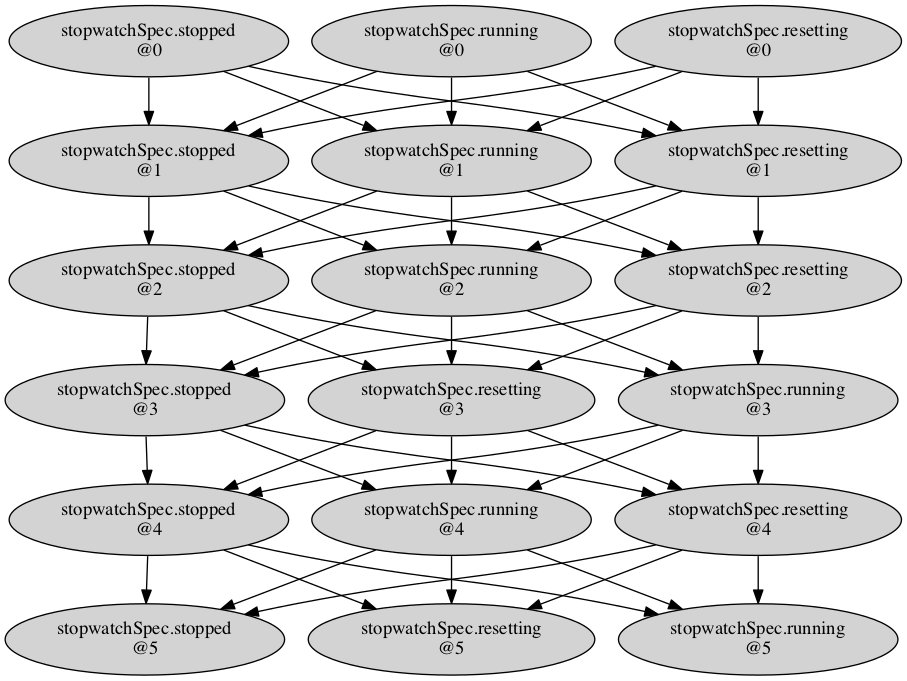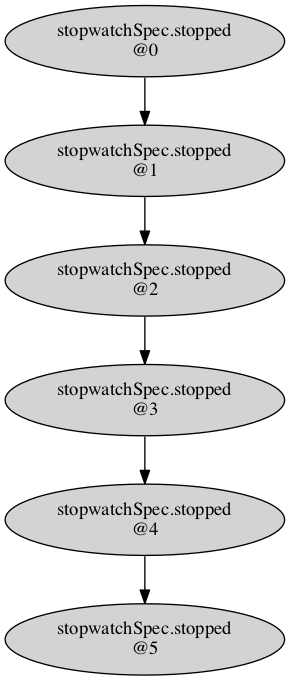Test Generation¶
Disclaimer: Test generation is, as of Kind 2 1.0, still a rather experimental feature. In particular, it works only for models whose nodes have inputs and outputs of simple type (int, real, bool, and enum), not structured type (record, tuple, or array). There is a lot of room for improvement and the Kind 2 team welcomes feedback / bug reports.
Most test generation techniques analyze the syntax of the model they run on to generate test cases satisfying some coverage criteria. Kind 2 does not follow this approach but instead generates tests based on the specification, more precisely the modes of the specification.
Kind 2’s test generation was developed in a context where the actual implementation of the components is outsourced. That is, a model of the system is written in-house based on some specification. The model is then verified correct with respect to its specification, using Kind 2 of course, before the specification is given to external sub-contractors that will eventually produce some binaries but will not give access to their source code. At this point, there is a need to test these binaries in-house.
In this context, syntactic test generation is arguably not appropriate as it would be based on the syntax of the model, not that of the actual source code of the binaries. There is no reason to believe any connection between the two. Now, the only thing we know of the binaries is that they are supposed to verify the specification. For this reason, Kind 2’s test generation ignores the syntax of the input model and instead builds on contracts (see Contract Semantics), and more precisely on the notion on mode.
Combinations of modes as abstractions¶
Modes specify behaviors specific to a situation in a contract, and can be seen as abstractions of the states allowed by the assumptions of the contract. Note that because of the mode exhaustiveness check, there is always at least one mode active in any reachable state.
One can explore, starting from the initial states, the mode that can be
activated up to some depth. For example, consider the following stopwatch
system:
contract stopwatchSpec ( tgl, rst : bool ) returns ( c : int ) ;
let
var on: bool = tgl -> (pre on and not tgl) or (not pre on and tgl) ;
assume not (rst and tgl) ;
guarantee c >= 0 ;
mode resetting ( require rst ; ensure c = 0 ; ) ;
mode running (
require not rst ; require on ; ensure c = (1 -> pre c + 1) ;
) ;
mode stopped (
require not rst ; require not on ; ensure c = (0 -> pre c) ;
) ;
tel
node previous ( x : int ) returns ( y : int ) ;
let
y = 0 -> pre x ;
tel
node stopwatch ( toggle, reset : bool ) returns ( count : int ) ;
(*@contract
import stopwatchSpec ( toggle, reset ) returns ( count ) ;
*)
var running : bool ;
let
running = (false -> pre running) <> toggle ;
count = if reset then 0 else
if running then previous(count) + 1 else previous(count) ;
tel
It seems that any of the three modes from the contract can be active at any point, since their activation only depends on the values of the inputs. We can ask Kind 2 to generate the graph of mode paths up to some depth (5 here):
kind2 --testgen true --testgen_len 5 stopwatch.lus
This will generate the following graph (and a lot of other files we will discuss below but omit for now):

Stopwatch DAG¶
The graph confirms our understanding of the specification, each mode can be activated at any time. Say now we made a mistake on the assumption:
assume not (rst or tgl) ;
It is now illegal to reset or start the stopwatch. The graph is generated very quickly as with this assumption the system cannot do anything:

Stopwatch mistake DAG¶
N.B. In this simple system, only one mode could be active at a time. This is not the case in general. See for example the mode graphs for the mode logic or the full model of the Transport Class Model (TCM) case study.
Generating test cases¶
Since Kind 2 can explore the traces of combinations of modes that can be activated from the initial states, generating test cases is simple. Each test case is simply a trace of inputs, or witness, triggering a different path of mode combinations in the DAG discussed above.
Each witness is logged in CSV file. A glue XML file lists all the test cases and provides additional information such as the trace of mode combinations they triggered in the model.
But aren’t the witnesses still based on how the model is written?
Yes they are. There is no way to completely abstract the model/prototype away, nor is it desirable. Generating test cases solely on the specification is not realistic unless the specification is extremely strong and precise, which it very rarely is. (Also, if it was, it would arguably be easier to produce the object code as a refinement of the specification using the B-method for instance.)
Oracle generation¶
The point of generating these test cases is to eventually run them on an executable version of the model to check whether it crashes and respects the specification.
For convenience, Kind 2 automatically generates an executable oracle along
with the test cases. It takes the form of a Rust project in the oracle
subdirectory of the Kind 2 output directory. The best way to learn about how
this oracle behaves is to generate and read its documentation by running
cargo doc in said subdirectory and opening target/doc/<system>/index.html.
The idea is that this oracle will read comma-separated values on its standard input. These values correspond to the inputs fed to the System Under Test (SUT), followed by the values returned by the SUT. The oracle prints back the truth values of the guarantees / modes of the original contract as comma-separated values. (How the outputs are organized depends on your system and is currently not standardized. Refer to the oracle’s documentation.)
Keeping in mind a test case is a sequence of input values each corresponding to a step or cycle for the SUT, the workflow is
read inputs
insfor current step from the test case filefeed it to the SUT, obtaining some outputs
outswrite
insandoutsas comma-separated values on the oracle’s standard inputread the truth values for the original contract on the oracle’s standard output
Note: In general, the values for the contract depend on previous values of the SUT’s inputs / outputs. In the workflow described above, the oracle keeps running between each step so that it can remember the information it needs from the previous steps to produce the next guarantee/mode truth values.
An example of a Test Execution Engine¶
A Test Execution Engine (TEE) compatible with Kind 2’s test cases and oracles is available here:
Teas is written in Python, and is able to compare a binary with Kind 2’s
test cases using the oracle described above.
Disclaimer: Like Kind 2’s test generation feature,
Teasis in an experimental and unstable state.